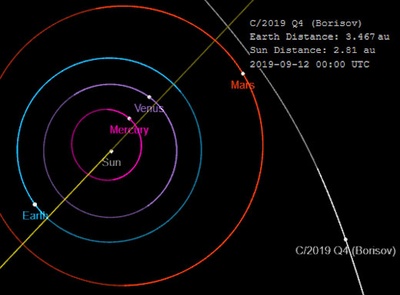A possible interstellar comet
'Oumuamua is not alone. Another interstellar visitor appears to be passing through the solar system--and this time it's definitely a comet. Ukrainian amateur astronomer Gennady Borisov discovered the object, now named C/2019 Q4 (Borisov), approaching from beyond the orbit of Mars on Aug. 30th.
Based on observations gathered since Borisov discovered the distant fuzzball, the comet seems to be following a hyperbolic orbit with an eccentricity greater than 3.5. This means the comet is unbound to the sun. Indeed, it is moving some 30.7 km/s (68,700 mph) too fast for the sun's gravity to hang onto it. Comet Borisov is a first time visitor to the inner solar system, and after this flyby it will return to deep space.
Comet Borisov will make its closest approach to the sun (2 AU) around Dec. 7th. Three weeks later, near the end of December, it will make its closest approach to Earth (also 2 AU). At the moment the comet is very dim, around magnitude +18. How bright it may become by December is anyone's guess.
The first known interstellar object to visit our solar system, 'Oumuamua, caused a sensation when it was discovered racing away from the sun in late 2017. Speculation about its nature ranged from an alien spacecraft to a fossil exocomet. Astronomers still aren't sure what it was. Comet Borisov, on the other hand, appears to have a fuzzy atmosphere (a "coma") and perhaps a stubby tail--signs that it really is a comet.
Because Comet Borisov is still just entering the solar system, astronomers will have plenty of time to study it in the months ahead. Is it truly interstellar? What are comets from other solar systems made of? Answers to these and many other questions are forthcoming.
Meanwhile, if you are a skilled amateur astronomer and wish to observe Comet Borisov, you may find orbital elements for pointing your telescope here and here.
